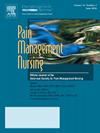Pain Experiences and Coping Methods of Living Liver Donors Experiencing Chronic Pain After Surgery: Qualitative Study
IF 2.1
4区 医学
Q2 NURSING
引用次数: 0
Abstract
Background
Living liver donors are known to experience many physical symptoms such as pain in the postoperative period.
Aim
This qualitative study was conducted to examine pain experiences and coping methods of living liver donors experiencing postoperative chronic pain.
Methods
The study sample consisted of 16 living liver donors. Data were collected using a personal information form and a semi-structured questionnaire. Quantitative data were analyzed as number, mean, standard deviation, and percentage. Qualitative data were analyzed within the framework of thematic and content analysis methods.
Results
The mean postoperative chronic pain rate of living liver donors was 4.5. Eight of these people reported experiencing sudden, pinprick-like pain after liver transplantation. Living liver donors stated that the greatest factor that increased their pain was exertion/spontaneous movement. Half of them stated that the pain they experienced after transplantation had no impact on their daily life activities. Most of the living liver donors stated that the pain they experienced had no impact on their social lives; however, it caused sadness and psychological deterioration. The most preferred method to cope with pain was the use of medication.
Conclusions
Living liver donors experienced moderate postoperative chronic pain, and a significant proportion of them reported psychological symptoms related to the pain they experienced. A multidisciplinary pain team can help with pain management by providing training conducted in transplant centers.
活体肝供者术后慢性疼痛的疼痛经历及应对方法:定性研究。
背景:已知活体肝供者在术后会经历许多身体症状,如疼痛。目的:探讨活体肝供者术后慢性疼痛的疼痛经历及应对方法。方法:选取16例活体肝供者作为研究对象。数据通过个人信息表格和半结构化问卷收集。定量资料采用数、均值、标准差、百分比进行分析。定性数据在专题和内容分析方法的框架内进行分析。结果:活体肝供者术后平均慢性疼痛率为4.5。其中8人报告在肝移植后出现突发性针刺样疼痛。活体肝脏供者表示,增加他们疼痛的最大因素是用力/自发运动。其中一半的人表示,移植后的疼痛对他们的日常生活活动没有影响。大多数活体肝脏捐赠者表示,他们所经历的痛苦对他们的社交生活没有影响;然而,它引起了悲伤和心理恶化。治疗疼痛最常用的方法是使用药物。结论:活体肝供者术后出现中度慢性疼痛,其中相当大比例的人报告了与他们所经历的疼痛相关的心理症状。一个多学科的疼痛团队可以通过在移植中心提供培训来帮助疼痛管理。
本文章由计算机程序翻译,如有差异,请以英文原文为准。
求助全文
约1分钟内获得全文
求助全文
来源期刊

Pain Management Nursing
医学-护理
CiteScore
3.00
自引率
5.90%
发文量
187
审稿时长
>12 weeks
期刊介绍:
This peer-reviewed journal offers a unique focus on the realm of pain management as it applies to nursing. Original and review articles from experts in the field offer key insights in the areas of clinical practice, advocacy, education, administration, and research. Additional features include practice guidelines and pharmacology updates.
 求助内容:
求助内容: 应助结果提醒方式:
应助结果提醒方式:


